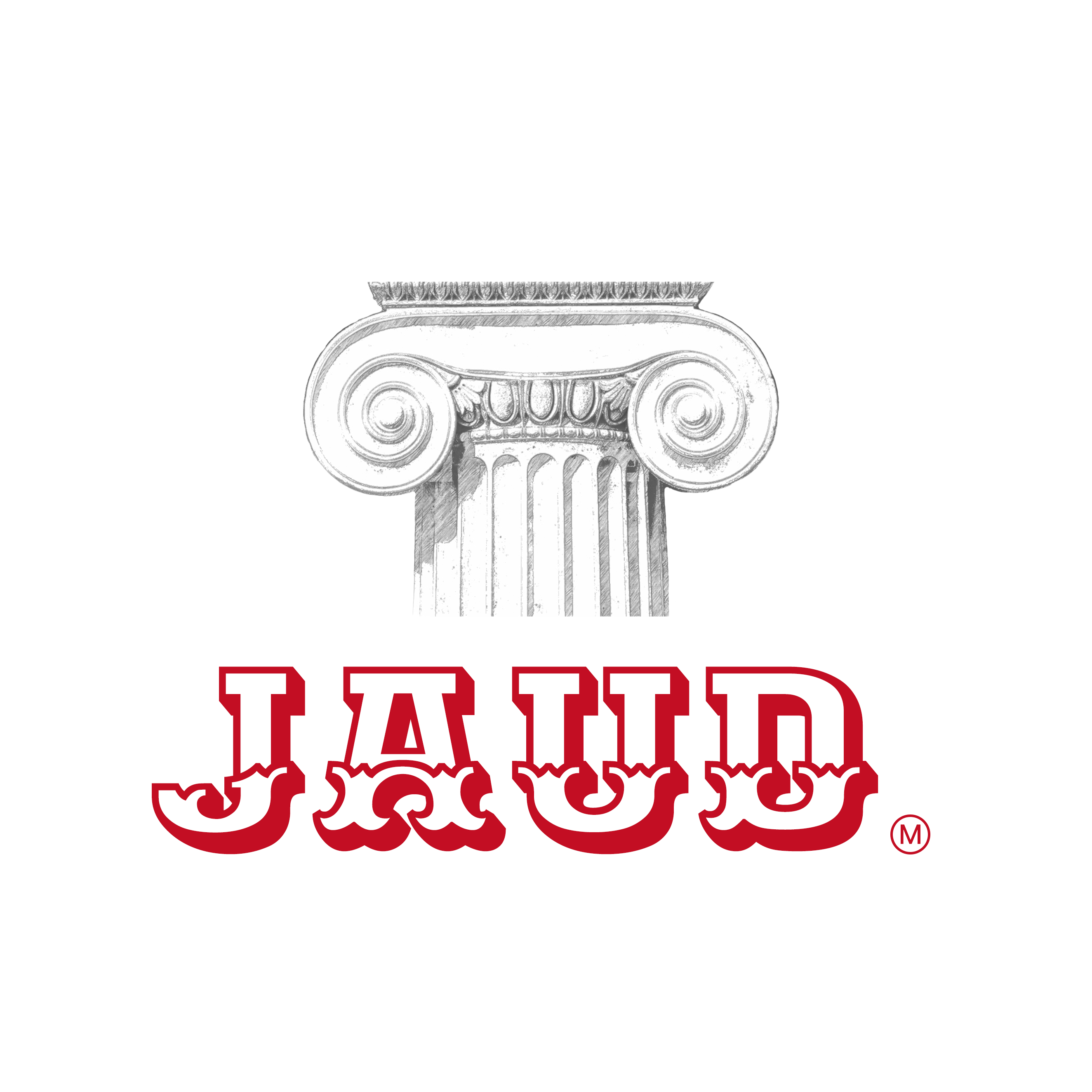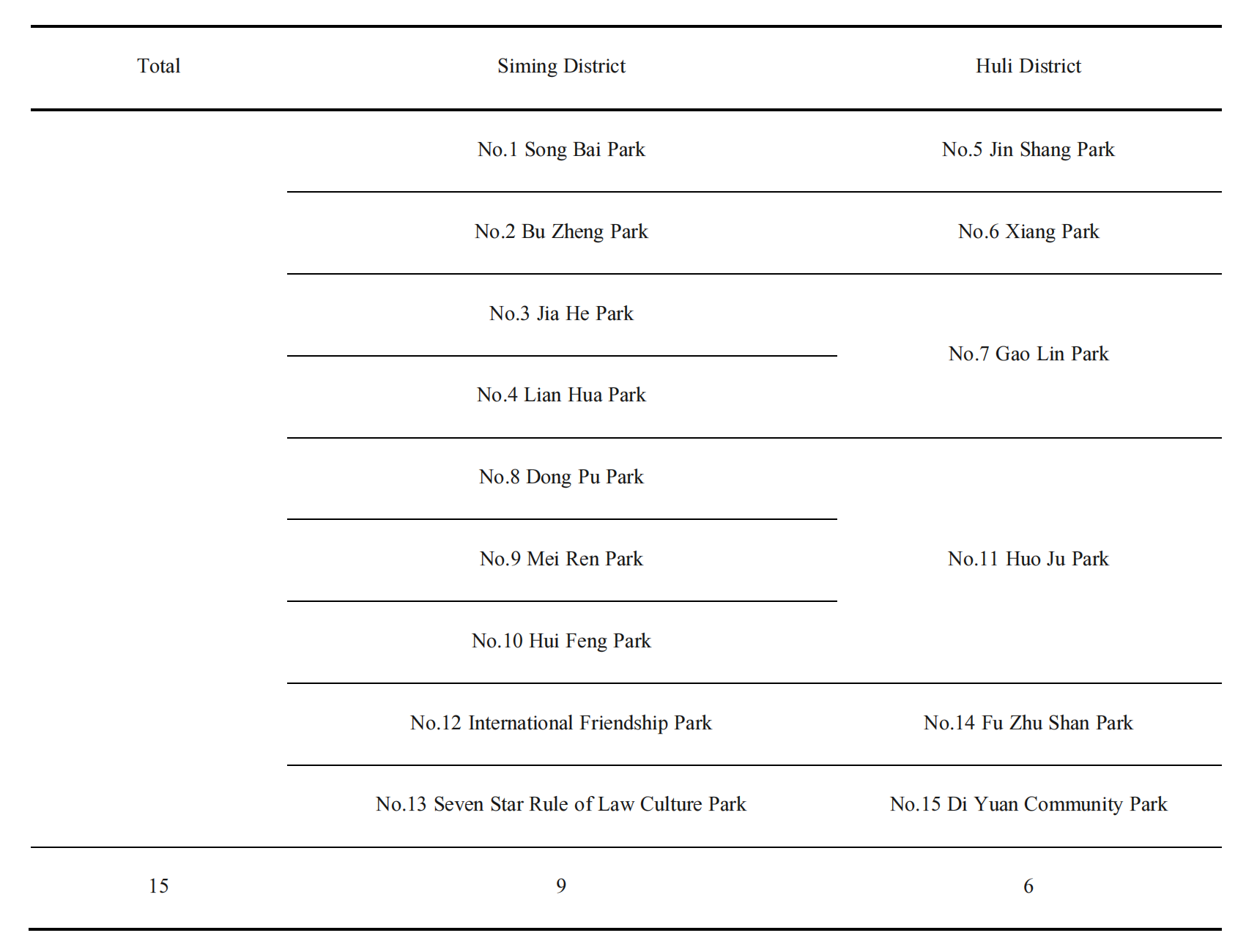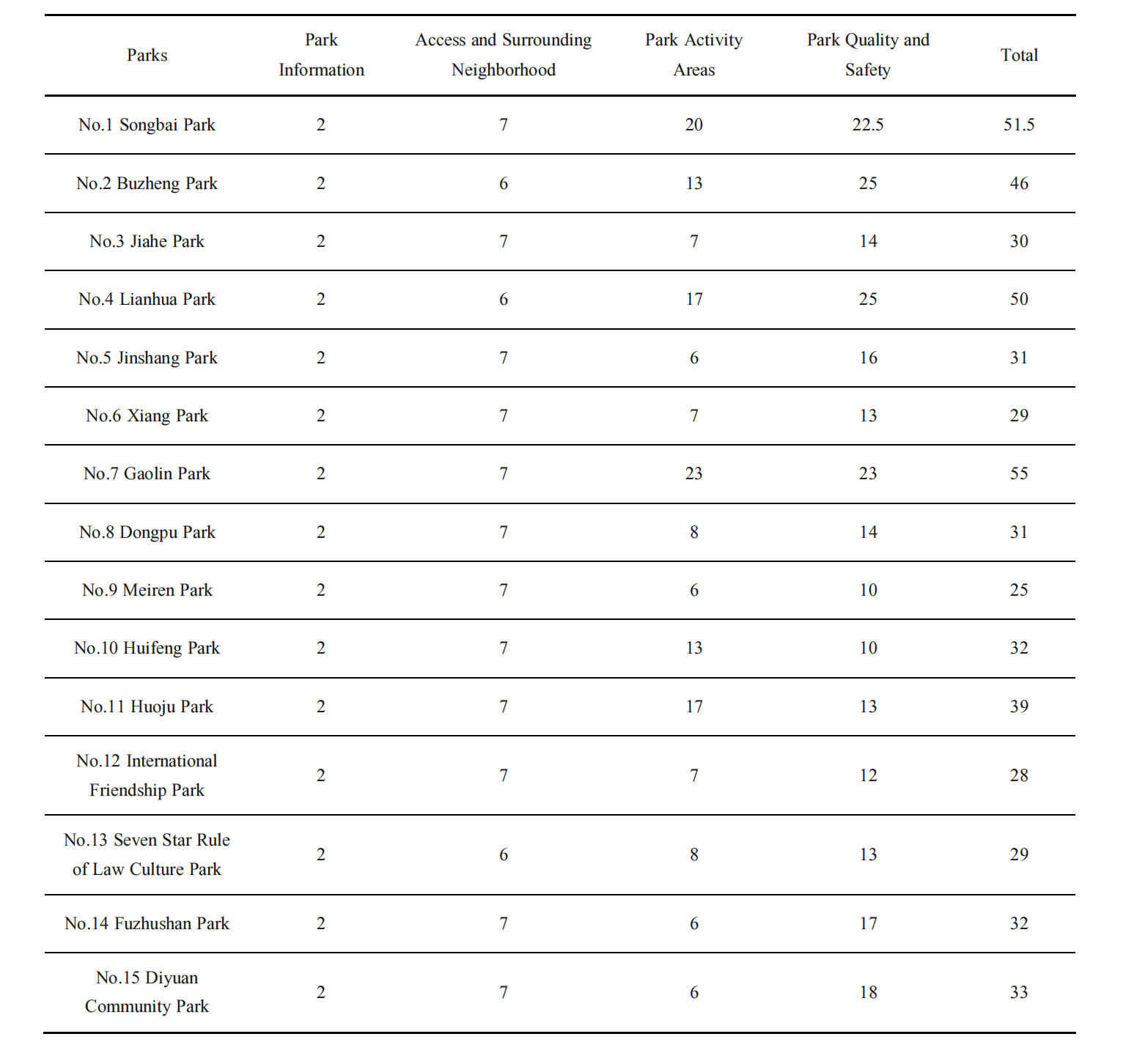Data Collection
The data collection process followed the procedures outlined in the CPAT. The CPAT consists of four main sections: Park Information, Access and Surrounding Neighborhood, Park Activity Areas, and Park Quality and Safety. The 15 community parks on Xiamen Island were assessed for features related to promoting physical activity from each of these sections, aiming to conduct a comprehensive, fair, effective, and unbiased evaluation of the community parks on Xiamen Island to promote the physical health of the elderly population.
According to Kaczynski et al. (2012) [14], the developers of CPAT, the tool’s development was based on extensive community participation and multistage field testing. Each community park should be independently assessed by at least two evaluators to ensure the reliability and validity of the data. Therefore, three elderly individuals were randomly invited from each of the 15 community parks to participate in the assessment, resulting in a total of 45 participants. Before data collection, the participants received basic training, including theoretical knowledge and practical application of the CPAT, to ensure their accurate understanding and application of the assessment criteria.
Finally, the data collection process adhered to strict ethical guidelines, ensuring the privacy of participants and the confidentiality of the data.
Data Analysis
After data collection, the consistency and reliability of assessments performed by different participants were first tested via kappa statistics to confirm the credibility and reliability of the data in the CPAT questionnaire [15].
In the CPAT questionnaire, most questions were designed with binary response (yes/no) or ordinal variable response (all or most/approximately half /none) formats. To clearly reflect the data, “yes” and “all or most” were assigned a score of 1, “no” and “none” were assigned a score of 0, and “approximately half” was assigned a score of 0.5. This approach allowed us to quantify participants’ responses and perform further data analysis.
Role of Community Parks in Promoting Physical Activity
Community parks play a Crucial role in promoting physical activity. Their proximity serves as the greatest advantage, as elderly individuals with declining physical abilities are not well suited for long-distance travel. The accessibility and familiarity of community parks address the issues of distance and social interaction, providing familiar venues for socializing and engaging in activities [10]. This instills a sense of security and positively impacts their physical and mental well-being. Moreover, community parks offer an environment conducive to physical activities and social interactions, accommodating activities, such as jogging, walking, yoga, and Tai Chi. Notably, the green spaces within community parks provide residents with opportunities to connect with nature, which is crucial for improving physical and mental health, as well as alleviating the stresses of daily life.
The need for adaptability in medical services due to an aging society was highlighted in the study by Sui et al. (2023), who focused on the balance between supply and demand in health care. This big data-driven research underscores the impact of well-maintained community parks on reducing health care burdens by fostering preventative health habits among the elderly [11]. A study by Chen et al. (2015) on disability assessment among the elderly population in Xiamen highlighted the necessity for inclusive urban planning to support the health and well-being of older adults. The findings emphasize that carefully designed community parks are crucial in promoting an active lifestyle, which can mitigate some of the adverse effects associated with an aging population [12].
It is evident that progress in urban development and public health strategies must consider the unique needs of the elderly population, ensuring that community parks are accessible, safe, and equipped with facilities that encourage physical activities tailored to the abilities and interests of older adults. The creation of supportive structures through these parks can improve the physical health conditions of the elderly and promote the development of age-friendly cities.
Methodology
Study Area
Xiamen city is divided into Siming District, Huli District, Jimei District, Tong’an District, Xiang’an District, and Haicang District. This study focuses primarily on Xiamen Island, which is composed of the Siming District and Huli District. The aging situation on Xiamen Island is severe, and almost 50% of the city’s elderly population lives on the island. However, the area of the island accounts for only 10% of Xiamen [9]. Hence, the aging issue on Xiamen Island is particularly prominent, requiring special attention and research to improve the quality of life for the elderly and promote the improvement and upgrading of public green space infrastructure within the island.
According to the “Standard for Classification of Urban Green Space” (SCUGS) issued by the Ministry of Housing and Urban-Rural Development of the People’s Republic of China, with numbers CJJ/T85-2002 and the latest version CJJ/T85-2017, the Xiamen Municipal People’s Government has identified a total of 15 community parks within Xiamen Island (Table 1). Therefore, these 15 community parks were included in the study area.
Importance of Physical Activity for Elderly Health
As individuals age, the importance of physical activity becomes increasingly pronounced, as it can significantly prevent various chronic diseases, enhance quality of life, and is pivotal for maintaining and improving the physical and mental well-being of the elderly population.
Among the elderly population, physical exercise has a significant effect on the prevention and management of noncommunicable diseases, such as cardiovascular diseases and diabetes [4]. Regular moderate-intensity exercise contributes to lowering blood pressure, improving cardiac function, increasing metabolic rates and ensuring optimal physical health [5]. For example, the traditional Chinese exercise Tai Chi is a classic form of moderate-intensity exercise. It improves the physical health, mental well-being, and cognitive function of cancer survivors through its meditative elements [6].
In addition to its physical impacts, physical exercise has positive effects on cognitive function and mental health in the elderly population. Research has revealed that elderly individuals who exercise regularly perform better on cognitive tests than do those who do not exercise [7]. Furthermore, physical activity can reduce the risk of developing depression and anxiety disorders, which play crucial roles in enhancing life satisfaction and overall well-being among the elderly population [8].
The health-promoting effects of sports facilities and activity programs in parks are evident. In particular, playing mahjong and cards are the most common leisure and entertainment activities for the elderly in Chinese communities [9]. Providing a safe, accessible, and appealing environment can encourage elderly individuals to engage more actively in regular physical activities.
Participant Selection
This study recruited participants from the elderly population aged 60 years and above who utilize community parks in the Siming and Huli districts through a random sampling method. This approach ensures that every elderly individual in the target population has an equal chance of being included in the study, aiming to ensure the diversity of the sample without categorizing or restricting it on the basis of specific characteristics, ethnicities, or genders. Through this method, participants were randomly selected without bias, thereby enhancing the generalizability of the research findings.
Prior to participating in the survey, each participant was provided with detailed information regarding the research objectives, procedures, and potential risks and benefits. They were asked to voluntarily provide informed consent, ensuring that their participation was entirely voluntary and that they could withdraw from the study at any time without consequences.
Study Tool
The Community Park Audit Tool (CPAT) is a tool specifically designed to assess community parks, comprehensively considering the potential impact of park environments on physical activity while particularly considering the diversity and engagement of community members. It allows different stakeholders to audit community parks quickly and reliably, evaluating their potential for promoting physical activity [13]. The CPAT is suitable for assessing Xiamen’s community parks from the perspective of promoting physical activity among elderly individuals. The evaluation of park quality and safety aligns well with the needs of elderly individuals, who require safe and well-maintained environments to encourage their participation in physical activities.
Moreover, the CPAT’s user-friendliness makes it an accessible tool for nonprofessionals, meaning that community members without professional research backgrounds can participate in park assessments, greatly expanding the tool’s usability and reach. It not only provides scientifically reliable evaluation results but also encourages and promotes community engagement and collaborative creation of healthy community environments.
Abstract
This study aims to evaluate the impact of community parks in Xiamen on promoting physical activity among older adults. The study employs the Community Park Audit Tool (CPAT) to assess 15 community parks on Xiamen Island. A total of 45 elderly participants were randomly selected to complete the CPAT questionnaire. Data collection focused on four key areas: park information, access and surrounding neighborhoods, park activity areas, and park quality and safety. These findings indicate that well-maintained community parks significantly increase physical activity levels among older adults. Specifically, natural features, diverse activity areas, safety measures, and aesthetic elements promote the health of older adults. The CPAT assessment results revealed that Gaolin Park (No.7) received the highest score, indicating its positive role in promoting physical activity among elderly individuals, whereas Meiren Park (No.9) received the lowest score, suggesting that improvement is needed to better meet the needs of the elderly and enhance their health. The CPAT provides valuable insights for urban planners and decision-makers to optimize the design and management of community parks, thereby better meeting the needs of older adults and promoting their health and well-being.
References
1. “China Population Census Yearbook 2020,” National Burean of statistics of China, https://www.stats.gov.cn/sj/ndsj/2020/indexeh.htm.
2. Fiona C. Bull, Salih S. Al-Ansari, Stuart Biddle et al., “World Health Organization 2020 guidelines on physical activity and sedentary behaviour,” British journal of sports medicine 54, no. 24 (2020): 1451-1462. [CrossRef]
3. Yongling Li, Yanliu Lin, Stan Geertman et al., “Accessibility-based equity of public facilities: A case study in Xiamen, China,” Applied Spatial Analysis and Policy 14 (2021): 947-968. [CrossRef]
4. Shun-Hsi Tsai, Hao-Chien Cheng, and Hung-Wen Liu, “Supervised high-load resistance training for improving muscle strength and quality in prediabetic older adults: A pilot randomized controlled trial,” Geriatric Nursing 48 (2022): 350-355. [CrossRef]
5. Fanzhuo Ding, Yuwei Zheng, Jingyuan Zhu et al., “Sustainable Well-being of Rural Environment: Elderly-oriented Evaluation of Outdoor Public Space Design in Suburban Villages-A Case Study of Beijing,” (2023).
6. Lee Smith, Dan Gordon, Adrian Scruton et al., “The potential yield of Tai Chi in cancer survivorship,” Future Science OA 2, no. 4 (2016): FSO152. [CrossRef]
7. Rui-xia Jia, Jing-hong Liang, Yong Xu et al., “Effects of physical activity and exercise on the cognitive function of patients with Alzheimer disease: a meta-analysis,” BMC geriatrics 19 (2019): 1-14. [CrossRef]
8. Ben Singh, Timothy Olds, Rachel Curtis et al. “Effectiveness of physical activity interventions for improving depression, anxiety and distress: an overview of systematic reviews,” British journal of sports medicine 57, no. 18 (2023): 1203-1209. [CrossRef]
9. Meng Liu, Xiongkai Zheng, Jiancai Fan et al., “Self-Driven Power” in the Sustainable Social Innovation Design of Ageing Districts—Based on an Investigation into the Southern Spring Town Historical District in Wuxi,” (2023). [CrossRef]
10. Yiyao Li, “Evaluation of the Walkability of Urban Streets on Xiamen Island Based on the Hierarchy of Walking Needs” ((M.A. thesis, Huaqiao University, 2022).
11. Jinling Sui, Tao Lin, Guoqin Zhang et al., “Equity and Driving Factors of Medical Service Supply–Demand Balance for the Elderly in Rapidly Urbanized Communities Based on Big Data Analysis—A Case Study of Xiamen City,” Sustainability 15, no. 10 (2023): 8014. [CrossRef]
12. Wei Chen, Ya Fang, Fanzhen Mao et al., “Assessment of disability among the elderly in Xiamen of China: a representative sample survey of 14,292 older adults,” PloS one 10, no. 6 (2015): e0131014. [CrossRef]
13. Yearbook of Xiamen Special Economic Zone, (2020), Xiamen Municipal Bureau of Statistics, Xiamen University Press.
14. Andrew T.Kaczynski and Sonja A. Wilhelm Stanis, and Gina M. Besenyi, “Development and testing of a community stakeholder park audit tool,” American journal of preventive medicine 42, no. 3 (2012): 242-249. [CrossRef]
15. Mary L McHugh, “Interrater reliability: the kappa statistic.” Biochemia medica 22, no. 3 (2012): 276-282. [CrossRef]
16. L. Y. Song, Y. Q. Chen, M. H. Liu et al., “The Current Situation Study on the Physical Fitness of Elderly in Xiamen,” Journal of Sports Science Research 19, no. 4 (2015): 40-44.
17. J. F. Lin, X. M. Chen and Y. Y. Xu, “An Investigation into the Aged' s Physical Exercise at Golden Delta of Southern Min,” Journal of Quanzhou Normal University 21, no. 4 (2003): 83-87.
18. Kirsi E. Keskinen, Merja Rantakokko, Kimmo Suomi et al., “Nature as a facilitator for physical activity: Defining relationships between the objective and perceived environment and physical activity among community-dwelling older people,” Health & place 49 (2018): 111-119. [CrossRef]
© 2024 by the authors. Published by Michelangelo-scholar Publishing Ltd.
This article is published under the Creative Commons Attribution-NonCommercial-NoDerivs 4.0 International (CC BY-NC-ND, version 4.0) license (https://creativecommons.org/licenses/by-nc-nd/4.0/), which permits non-commercial use, distribution, and reproduction in any medium, provided the original work is properly cited and not modified in any way.
Share and Cite
Chicago/Turabian Style
Xinyu Lin, Wardah Fatimah Mohammad Yusoff and Mohd Khairul Azhar Mat Sulaiman. "Assessment of Xiamen Community Parks to Promote Physical Activity for Older Adults." JAUD 1, no.1 (2024): 1-13.
AMA Style
Lin XY, Yusoff WFM, Sulaiman MKAM. Assessment of Xiamen Community Parks to Promote Physical Activity for Older Adults. JAUD. 2024; 1(1): 1-13.
Table of Contents
- Abstract
- Introduction
- Methodology
- Results
- Discussion
- Conclusion
- Conflicts of Interest
- Funding
- References
Introduction
Xiamen's Aging Population and Public Health
In Xiamen, similar to many urban areas, the older adult population is rapidly growing due to increased life expectancy and declining birth rates. According to data from the National Bureau of Statistics 2020, as of the Seventh National Population Census, Xiamen city’s population aged 60 and above had reached 493,000, accounting for 9.56% of the permanent resident population. Compared with the Sixth National Population Census, the proportion of the population aged 60 years and above rose by 2.63 percentage points [1]. Confronted with the increasingly severe situation of population aging, promoting the health and well-being of older adults has become a pressing public health issue that needs to be addressed.
The increase in the older adult population signifies a greater need for attention toward the prevention and management of chronic diseases, as well as the promotion of healthy lifestyles, particularly in encouraging participation in physical activities among older adults. As a means of maintaining and improving health outcomes, physical activity has gained widespread recognition because of its ability to prevent and manage chronic diseases [2]. These efforts aim to alleviate the negative impacts associated with aging, enabling older adults to better enjoy life, create social value, and bolster self-confidence. Therefore, the World Health Organization (WHO) has been dedicated to building an active and positive aging society.
With improvements in the urban environment, sanitary conditions, and health care services on Xiamen Island, the overall health status of the elderly population in Xiamen has been steadily increasing. Community parks play a pivotal role in this strategic initiative. These parks offer residents diverse physical exercise options. Through active participation in daily activities, elderly community members can self-manage their health conditions, alleviating the burden on the health care system. From a public health perspective, community parks not only increase the sanitary standards and accessibility of residential areas but also substantially contribute to health promotion and disease prevention efforts on Xiamen Island through their multifaceted functions [3].
Conclusion
The application of CPAT in assessing community parks on Xiamen Island for promoting physical activity has revealed important insights into their overall effectiveness and attractiveness, particularly for older residents. The kappa values used to measure the inter-rater reliability of the CPAT survey questionnaire sections indicate substantial agreement among the raters for most parks, suggesting a high level of data reliability. This reliability is crucial for stakeholders aiming to ensure that the assessment results accurately reflect the true conditions of the parks.
The CPAT assessment results reveal several key factors that are essential for enhancing the attractiveness and usability of community parks in Xiamen for older adults, thereby promoting their physical activity. First, the presence of lakes significantly increases park utilization and activity levels among older adults. Parks with these features, such as No.11 Huoju Park, No.1 Songbai Park, and No.4 Lianhua Park, received higher scores in the CPAT assessment. Second, providing diverse activity areas, such as fitness equipment, basketball courts, and tennis courts, is crucial for promoting physical exercise among older adults. Parks with multiple activity areas, such as No.7 Gaolin Park, No.1 Songbai Park, and No.11 Huoju Park, are more popular among older adults in terms of park activity areas.
Furthermore, the safety and aesthetic features of community parks play a vital role in attracting elderly people and encouraging their participation in outdoor activities. The presence of park staff, security personnel, and cameras provides a sense of safety and reassurance for older adults. Additionally, aesthetic elements, such as landscaping, artistic features, historical or educational features, and water features significantly contribute to the overall appeal and enjoyment of the park experience for elderly individuals.
However, the assessment also identifies areas for improvement in Xiamen’s community parks. The lack of emergency devices and inconsistent lighting levels across parks are concerns that need to be addressed to ensure the safety and well-being of older adults. Moreover, the limited availability of drinking fountains and food/vending machines in most parks may hinder the convenience for elderly individuals.
According to the total scores, No.7 Gaolin Park has the highest score, indicating that it plays a positive role in promoting physical activity among older adults. No.9 Meiren Park has the lowest score, suggesting that improvements are needed to better meet the needs of older adults and promote their health. The CPAT rankings of the parks are as follows: No.7 Gaolin Park > No.1 Songbai Park > No.4 Lianhua Park > No.2 Buzheng Park > No.11 Huoju Park > No.15 Diyuan Community Park > No.14 Fuzhushan Park > No.10 Huifeng Park > No.8 Dongpu Park > No.5 Jinshang Park > No.3 Jiahe Park > No.13 Seven Star Rule of Law Culture Park > No.6 Xiang Park > No.12 International Friendship Park > No.9 Meiren Park.
In conclusion, the CPAT provides valuable insights into the strengths and weaknesses of Xiamen’s community parks in catering to the needs and preferences of older adults. The findings emphasize the importance of incorporating natural features, diverse activity areas, safety measures, and aesthetic elements in park design and management. By addressing the identified areas for improvement and leveraging the positive aspects highlighted in this study, stakeholders can create more age-friendly and inclusive community parks that promote the health and well-being of the elderly in Xiamen.
Park Quality and Safety
In the Quality and Safety section of the questionnaire, safety is a crucial indicator that determines whether older adults choose to visit community parks. Safety can be reflected in two aspects. All parks are equipped with park staff, security personnel, and cameras, which reassures older adults that they need not worry about being injured or fainting without anyone noticing while exercising outdoors. The second aspect is the park’s landscape elements and facilities are elderly- friendly, alleviating concerns about slipping or tripping and becoming hurt.
There is a consensus among community parks in Xiamen regarding rules posted about animals in the park: dogs are prohibited from entering the park, and consequently, dog waste pick-up bags are not provided. Older adults generally express support for banning dogs from the park, as many dog owners rarely dispose of dog waste, leading to environmental pollution and increasing difficulties in their outdoor activities. Additionally, grills or fire pits are prohibited in parks to prevent fire hazards. Furthermore, the lit areas in the parks generally cover >75% of the area, but the brightness levels vary, with some areas being very bright and others being very dark. However, brightness does not seem to be the primary concern for older adults, as they believe that an excessively bright park is a waste of resources and contributes to environmental pollution. Finally, public restrooms are a standard feature in all community parks and are maintained in good condition.
Several factors contributed to the differences in scores between the parks. The first is the presence of drinking fountain(s). Few community parks provide them, including No. 4 Lianhua Park, No. 2 Buzheng Park, and No. 1 Songbai Park. In these parks, drinking fountains are placed in prominent public areas for people to use. Only No. 4 Lianhua Park has a food/vending machine in a public area, while other parks do not provide them. Emergency devices are also relatively lacking in community parks. Many older adults express that, owing to their age and declining health, they sometimes suddenly lose balance or become injured while sleeping, and these emergencies require individuals to discover and use emergency devices to provide timely assistance.
Older adults consider aesthetic features in parks to be very important, particularly evidence of landscaping, artistic features, historical or educational features, and water features. These aesthetic elements play crucial roles in enhancing older adults’ activity engagement and overall enjoyment, attracting them to participate in outdoor activities, and ultimately improving their physical and mental health.
Therefore, on the basis of the assessments of older adults, the top five parks in terms of quality and safety scores are: No. 4 Lianhua Park > No. 2 Buzheng Park > No. 7 Gaolin Park > No. 1 Songbai Park > No. 15 Diyuan Community Park.
Results
Interrater Reliability
In the CPAT questionnaire, the number of items in each section is as follows: Park Information has 2 items, Access and Surrounding Neighborhood has 14 items, Park Activity Areas has 41 items, and Park Quality and Safety has 35 items. For each community park, three participants completed the questionnaire, and the interrater reliability among participants was tested via kappa values (Table 2).
The kappa values correspond to different levels of reliability: poor (0.00–0.19), fair (0.20–0.39), moderate (0.40–0.59), substantial (0.60–0.79), and almost perfect (0.80–1.00) [14]. Higher values indicate greater consistency among assessors, whereas lower values suggest lower consistency among assessors.
Assessment of Xiamen Community Parks to Promote Physical Activity for Older Adults
by
Xinyu Lin 1, 2, Wardah Fatimah Mohammad Yusoff 1 * , Mohd Khairul Azhar Mat Sulaiman 1
1. Faculty of Engineering and Built Environment, The National University of Malaysia, Bangi, Malaysia
2. Faculty of Arts and Crafts, Meizhouwan Vocational Technology College, Putian, China
* Author to whom correspondence should be addressed.
JAUD. 2024, 1(1), 1-13; https://doi.org/10.59528/ms.jaud2024.0717a1
Received: April 15, 2024 | Accepted: June 18, 2024 | Published: July 16, 2024
Conflicts of Interest
The authors have no conflicts of interest with respect to the research, authorship, or publication of this article.
Funding
This research did not receive any specific grant from funding agencies in the public, commercial, or not-for-profit sectors.
Access and Surrounding Neighborhood
The data in the Access and Surrounding Neighborhood section do not significantly differ among the studied parks. As these community parks primarily serve residential areas, the situations are very similar. One notable exception is No.2 Buzheng Park and No.13 Seven Star Rules of Law Culture Park, which are divided into two parts by a motor vehicle road, potentially posing safety threats to older adults when crossing. Therefore, traffic signals on roads are particularly important.
Moreover, older adults have their own perspectives on the question of whether safety or appearance concerns are present in the neighborhood surrounding the park. They typically place greater emphasis on a quiet, well-lit, and secure environment to facilitate their enjoyment of outdoor activities and maintain social interactions. Excessive noise is the primary concern for older adults, as it not only disrupts the tranquil atmosphere of the park but also affects their leisure experience and mental well-being. The second most pressing concern is insufficient lighting. In Xiamen, older adults engage in square dancing activities from 7–9 pm, which is closely related to nighttime safety issues.
Park Activity Areas
Park activity areas are the primary focus for most older adults, as their main reason for visiting parks is to engage in outdoor activities. The community parks in Xiamen share several common characteristics, such as the absence of football/soccer fields, baseball fields, swimming pools, splash pads, skate parks, and off-leash dog parks. Older adults indicated that the main reasons for this are twofold. First, some of these activities have lower participation rates in Xiamen than basketball and badminton do. Second, the maintenance costs for these facilities are relatively high. Furthermore, these amenities require larger areas, which is problematic given the limited space available in community parks [16, 17].
Fitness equipment/stations are present in almost all parks. However, only No.10 Huifeng Park, No.11 Huoju Park, No.1 Songbai Park, and No.7 Gaolin Park feature basketball courts, tennis courts, and volleyball courts.
Apart from the activity areas, the presence of a “lake” is a crucial factor that distinguishes the park activity area scores among the 15 parks. The parks that have a “lake” include No. 11 Huoju Park, No. 1 Songbai Park, and No. 4 Lianhua Park. Parks with lakes not only provide unique landscapes and recreational spaces for older adults but also enhance the overall attractiveness and utilization of the park. Natural features, such as lakes and water bodies, significantly increase park usage and the engagement of older adults in activities [18]. Consequently, these parks with lakes have higher scores in the CPAT assessment.
The trail surface is a controversial topic among older adults. Crushed stone is considered an unfriendly surface by older adults, as they are more likely to stumble on it during dry weather and slip during rainy conditions. The more crushed stone present, the less frequently older adults use the park. Dirt/mulch surfaces are aesthetically pleasing and contribute to plant growth and soil health, but they are difficult to maintain and may harbor mosquitoes. Paved surfaces are most suitable for older adults and offer good slip resistance and even paths, although they can become very hot during warm weather.
The top five parks in terms of the scores in the Park Activity Area section are No.7 Gaolin Park > No.1 Songbai Park > No.11 Huoju Park > No.4 Lianhua Park > No.10 Huifeng Park.
Discussion
Kappa Values for Community Parks
In the context of the CPAT questionnaire, kappa statistics were used to measure the interrater reliability across different sections of the community park evaluation. The kappa values indicate how consistently different evaluators rate the same items, with higher values representing greater agreement.
According to the classification of the kappa value ranges for community parks, almost all the parks exhibit kappa values within the substantial (0.60–0.79) and almost perfect (0.80–1.00) ranges, indicating that the consistency among most assessors is good and that the data reliability is high. However, there are several exceptions, such as No.6 Xiang Park, which has a lower kappa value (0.46) in the Park Quality and Safety section. To some extent, this situation is predictable because the Park Quality and Safety section is easily influenced by subjective judgments and temporal changes.
Overall, the CPAT questionnaire demonstrated high reliability when community parks were evaluated. This provides community stakeholders with a powerful tool to ensure that park assessment results accurately reflect the current state. From this, further analysis of quantitative data can be conducted.
Park Information
Park Information is the first section of the CPAT questionnaire, which includes two key questions: “Were you able to locate a map for this park?” and “Was the park easy to find onsite?”
First, the presence of a map and its accessibility are critical indicators for evaluating the transparency of park information. A clear and easily accessible map not only helps park users plan their visit routes but also provides necessary navigation assistance in cases of emergencies.
The ease of finding a park is another essential aspect of assessing its accessibility. If a park is easily identifiable and reachable onsite, it indicates that it has good signage and a prime geographical location.
According to the data, all 15 community parks have satisfactory scores of 2 points for both questions. This suggests that district parks perform well in terms of information transparency and accessibility. This is particularly important for older adults, as they may rely more on clear information and accessibility to help them engage in outdoor activities and promote their physical health.
Measurement data
Based on the Kappa statistics, the consistency among assessors is relatively high, indicating that the data is highly reliable. In the CPAT questionnaire, items with binary responses (yes/no) or ordinal variables (all or most/about half/none) were categorized as measurement data. For each measurable item, the number of assessors who selected “yes” or “all or most” was calculated. It should be noted that if a park has multiple identical sports fields, they were only counted once (Table 3).






